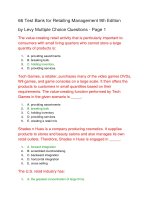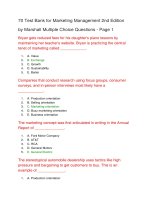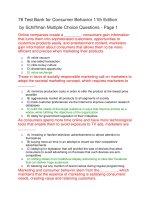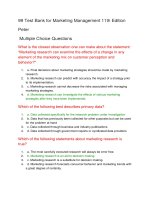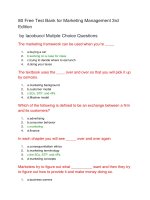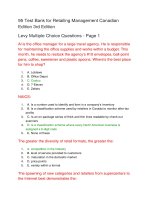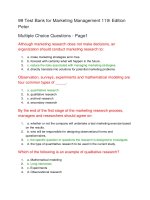69 test bank for operations management 11th edition stevenson
Bạn đang xem bản rút gọn của tài liệu. Xem và tải ngay bản đầy đủ của tài liệu tại đây (92.73 KB, 15 trang )
Test Bank for Operations Management 11th Edition
Stevenson
36 Test True – False Questions
33 Test Bank Multiple Choice Questions
33 Free Test Bank for Operations Management 11th
Edition Stevenson Multiple Choice Questions
In an assembly operation at a furniture factory, six employees assembled
an average of 450 standard dining chairs per 5-day week. What is the labor
productivity of this operation?
1.
A. 90 chairs/worker/day
2.
B. 20 chairs/worker/day
3.
C. 15 chairs/worker/day
4.
D. 75 chairs/worker/day
5.
E. none of the above
The Balanced Scorecard is a useful tool for helping managers translate
their strategy into action in the following areas:
1.
A. Sustainability; Flexibility; Efficiency; Technology
2.
B. Customers; Financial; Internal Business Processes; Learning and Growth
3.
C. Customization; Standardization; Efficiency; Effectiveness
4.
D. The Environment; The Community; Suppliers; Other Stakeholders
5.
E. Strategy; Tactics; Productivity; Profitability
Which of the following is true?
1.
A. Corporate strategy is shaped by functional strategies.
2.
B. Corporate mission is shaped by corporate strategy.
3.
C. Functional strategies are shaped by corporate strategy.
4.
D. External conditions are shaped by corporate mission.
5.
E. Corporate mission is shaped by functional strategies.
Competitiveness doesn't include:
1.
A. Productivity
2.
B. Effectiveness
3.
C. Profitability
4.
D. Operations Strategy
5.
E. Operations Management
Which of the following factors would tend to reduce productivity?
1.
A. improvements in workplace safety
2.
B. reductions in labor turnover
3.
C. more inexperienced workers
4.
D. reductions in the scrap rate
5.
E. none of the above
Gourmet Pretzels bakes soft pretzels on an assembly line. It currently
bakes 800 pretzels each 8-hour shift. If the production is increased to
1,200 pretzels each shift, then productivity will have increased by:
1.
A. 50%
2.
B. 33%
3.
C. 25%
4.
D. 67%.
In the 1970's and 1980's in the USA, organizations concentrated on:
1.
A. operations strategies
2.
B. improving quality
3.
C. marketing and financial strategies
4.
D. revising mission statements
5.
E. environmental issues
Scheduling personnel is an example of an operations management:
1.
A. mission implementation
2.
B. operational decision
3.
C. organizational strategy
4.
D. functional strategy
5.
E. tactical decision
Which of these factors affects productivity?
1.
A. methods and technology
2.
B. workers
3.
C. management
4.
D. a and b only
5.
E. all of the above
Which of the following is not a reason for poor performance of our
organization in the marketplace?
1.
A. placing too much emphasis on product/service design and too little on process
design
2.
B. failing to take into account customer wants and needs
3.
C. putting too much emphasis on short-term financial performance
4.
5.
D. taking advantage of strengths/opportunities, and recognizing competitive
threats
E. none of the above
Core competencies in organizations generally relate to:
1.
A. cost
2.
B. quality
3.
C. time
4.
D. flexibility
5.
E. all of the above
Value added can be calculated by:
1.
A. average productivity gains over time
2.
B. inputs divided by the outputs
3.
C. outputs divided by the inputs
4.
D. input plus output divided by two
5.
E. outputs minus inputs
Which of the following is not a key step toward improving productivity?
1.
A. developing productivity measures for all operations
2.
B. improving the bottleneck operations
3.
C. establishing reasonable goals for improvement
4.
D. considering incentives to reward workers
5.
E. converting bond debt to stock ownership
The ratio of good output to quantity of raw material input is called
1.
A. non-defective productivity
2.
B. process yield
3.
C. worker quality measurement
4.
D. total quality productivity
5.
E. quantity/quality ratio
The fundamental purpose for the existence of any organization is
described by its:
1.
A. policies
2.
B. procedures
3.
C. corporate charter
4.
D. mission statement
5.
E. bylaws
Years ago in the overnight delivery business, providing package tracking
capability gave some firms a competitive advantage. Now, all firms must
offer this capability simply to be in this line of business. This is an
example of ______________ becoming ____________ over time.
1.
A. Tactical implications; strategic
2.
B. Strategic implications; tactical
3.
C. Order winners; order qualifiers
4.
D. Profitability factors; productivity factors
5.
E. Order qualifiers; order winners
In the past, a significant reason why U.S. productivity was the highest in
the world was high:
1.
A. agricultural productivity
2.
B. manufacturing productivity
3.
C. labor productivity
4.
D. savings productivity
5.
E. governmental productivity
Suppose a country's productivity last year was 84. If this country's
productivity growth rate of 5% is to be maintained, this means that this
year's productivity will have to be _______.
1.
A. 88.2
2.
B. 79.8
3.
C. 82.8
4.
D. 78.9
5.
E. 4.2
Unique attributes of firms that give them a competitive edge are called
______________.
1.
A. Functional strategies
2.
B. Balanced scorecards
3.
C. Supply chains
4.
D. Core competencies
5.
E. Sustainable initiatives
Which of the following is considered to be a cause of poor U.S. global
competitiveness?
1.
A. the tendency to view labor as a cost factor to be minimized
2.
B. decision-making based on short-term horizons
3.
C. weaknesses in technological practice
4.
D. powerful trading partners
5.
E. all of the above
Productivity is expressed as:
1.
A. output plus input
2.
B. output minus input
3.
C. output times input
4.
D. output divided by input
5.
E. input divided by output
The external elements of SWOT analysis are:
1.
A. strengths and weaknesses
2.
B. strengths and threats
3.
C. opportunities and threats
4.
D. weaknesses and opportunities
5.
E. strengths and opportunities
Which of the following is not a key factor of competitiveness?
1.
A. price
2.
B. product differentiation
3.
C. flexibility
4.
D. after-sale service
5.
E. size of organization
Which of the following is not typically considered a cure for poor
competitiveness?
1.
A. remove communications barriers within organizations
2.
B. minimize attention to the operations function
3.
C. put less emphasis on short-term financial results
4.
D. recognize labor as a valuable asset and act to develop it
5.
E. improve quality
Time-based approaches of business organizations focus on reducing the
time to accomplish certain necessary activities. Time reductions seldom
apply to:
1.
A. product/service design time
2.
B. processing time
3.
C. delivery time
4.
D. response time for complaints
5.
E. internal audits
A firm pursuing a strategy based on customization and variety will tend to
structure and manage its supply chain to accommodate more
_____________ than a firm pursuing a strategy based on low-cost and
high-volume.
1.
A. Variation
2.
B. Streamlined flow
3.
C. Quality
4.
D. Capacity
5.
E. Productivity
___________ is generally used to facilitate an organization strategy that
emphasizes low cost.
1.
A. Speed to market
2.
B. Flexibility
3.
C. Customization
4.
D. Sustainability
5.
E. None of the above
Which of the following is not a factor that affects productivity?
1.
A. computer viruses
2.
B. design of the workspace
3.
C. use of the Internet
4.
D. standardizing processes
5.
E. wireless cellular phones
Increasing the service offered to the customer makes it more difficult to
compete on the basis of ______.
1.
A. order qualifiers
2.
B. customization
3.
C. quality
4.
D. price
5.
E. flexibility
For firms competing in worldwide markets, conducting
__________________ is more complex, since what works in one country or
region might not work in another.
1.
A. Productivity analysis
2.
B. Environmental analysis
3.
C. Strategy implementation
4.
D. Sustainability analysis
5.
E. Growth forecasting
For an organization to grow its market share, it must:
1.
A. advertise using multimedia
2.
B. lower prices
3.
C. exceed minimum standards of acceptability for its products or services
4.
D. establish an internet website
5.
E. broaden its mission statement
Product design and choice of location are examples of _______ decisions.
1.
A. strategic
2.
B. tactical
3.
C. operational
4.
D. customer focused
5.
E. design
6.
These decisions are made high in the hierarchy.
A productivity increase in one operation that doesn't improve overall
productivity of the business isn't
1.
A. worthwhile
2.
B. trivial
3.
C. competence-destroying
4.
D. an order winner
5.
E. an order qualifier
36 Free Test Bank for Operations Management 11th
Edition Stevenson True - False Questions
The majority of our textbook deals with tactical operations that support
established functional strategies.
1.
True
2.
False
Traditional strategies of business organizations have tended to emphasize
cost minimization or product differentiation.
1.
True
2.
False
Companies are required to use environmental scanning because of both
federal and state regulations regarding environmental pollution control.
1.
True
2.
False
As long as we match a competitor on quality and price we will gain market
share.
1.
True
2.
False
One major shortcoming of the Balanced Scorecard is that it doesn't tend
to take into account sustainability issues.
1.
True
2.
False
An organization that is twice as productive as its competitor will be twice
as profitable.
1.
True
2.
False
Productivity tends to be only a very minor factor in an organization's
ability to compete.
1.
True
2.
False
Environmental scanning is a search for events or trends that present
either threats or opportunities to the organization.
1.
True
2.
False
Productivity is directly related to the ability of an organization to compete.
1.
True
2.
False
A characteristic that was once an order winner may become an order
qualifier, and vice versa.
1.
True
2.
False
An example of a tactical operations management decision is determining
employment levels.
1.
True
2.
False
Mission statements should be as specific as possible regarding exactly
how they will be accomplished.
1.
True
2.
False
Wage and salary increases that are not accompanied by productivity
increases tend to exert inflationary pressures on a nation's economy.
1.
True
2.
False
If people would only work harder, productivity would increase.
1.
True
2.
False
National productivity is determined by averaging the productivity
measures of various companies or industries.
1.
True
2.
False
Productivity is defined as the ratio of input to output.
1.
True
2.
False
Improving efficiency will guarantee a similar improvement in productivity.
1.
True
2.
False
Organizational strategy should be determined without considering the
realities of functional area strengths and weaknesses since they can be
changed to meet our strategy.
1.
True
2.
False
Productivity is defined as the ratio of output to input.
1.
True
2.
False
The Balanced Scorecard is an attractive tool to use in the formation of
strategy.
1.
True
2.
False
The hierarchy and sequence of planning and decision-making is: mission,
organizational strategy, tactics, and operational decisions.
1.
True
2.
False
Global competition really only applies to multi-national organizations.
1.
True
2.
False
Outsourcing tends to improve quality but at the cost of lowered
productivity.
1.
True
2.
False
Strategy includes both organizational and functional strategies.
1.
True
2.
False
Functional strategies should be designed to directly support a firm's
mission.
1.
True
2.
False
Government statistics are a good source of data about productivity trends
in the service sector.
1.
True
2.
False
Tracking productivity measures over time enables managers to judge
organizational performance and decide where improvements are needed.
1.
True
2.
False
Services often don't fit simple yield measurements.
1.
True
2.
False
An example of an operational operations management decision is
inventory level management.
1.
True
2.
False
Time-based strategies focus on reducing the time required to accomplish
certain activities, such as new product development or delivery to the
customer.
1.
True
2.
False
A mission statement should provide a guide for the formulation of
strategies for the organization.
1.
True
2.
False
Competitiveness relates to the profitability of an organization in the
marketplace.
1.
True
2.
False
Standardization has the advantage of reducing variability.
1.
True
2.
False
A business that is rated highly by its customers for service quality will
tend to be more profitable than a business that is rated poorly.
1.
True
2.
False
An example of a strategic operations management decision is the choice
of where to locate.
1.
True
2.
False
Quality-based strategies focus on customer satisfaction by ensuring that
each product is carefully and thoroughly inspected prior to delivery to
prevent sending out bad product.
1.
True
2.
False
